You’ll find that the Google Pixel Watch 3, Samsung Galaxy Watch Series, and Garmin Venu models dominate the Spotify-compatible wearables market for Premium subscribers. These devices transform your wrist into a music control center, offering offline downloads, playlist navigation, and seamless playback management. Budget-friendly alternatives like TicWatch and Fossil Gen 6 provide similar WearOS functionality at lower prices. Each option balances battery life, storage capacity, and fitness integration differently to match your specific needs and usage patterns.
Google Pixel Watch 3: Premium Android Integration With Full Spotify Features
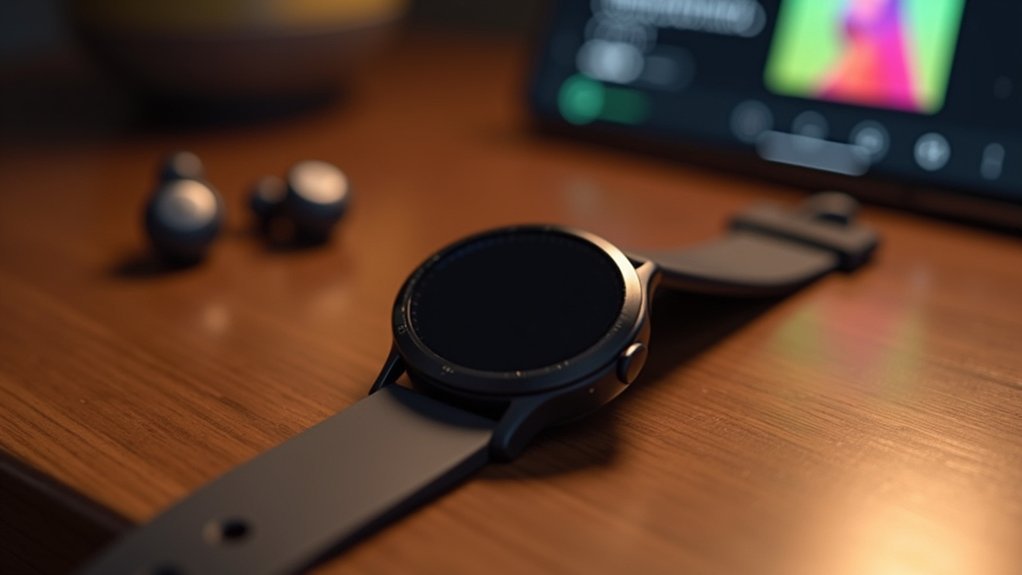
The Google Pixel Watch 3 transforms your wrist into an all-encompassing music control center, delivering seamless Spotify integration that rivals smartphone functionality.
You’ll access your entire music library directly from your wrist, thanks to Wear OS compatibility that supports Spotify’s complete feature set.
With your Spotify Premium subscription, you’ll enjoy offline playlist downloads, premium audio quality, and extensive playback controls including play, pause, skip, and shuffle.
The watch’s intuitive interface lets you navigate playlists and Liked Songs effortlessly, while Spotify Connect enables control over music on other devices. Simply rotate the Crown to navigate through your apps and locate Spotify for quick access to your music.
Effortless playlist navigation and seamless device control make the Pixel Watch 3 your ultimate music companion on the go.
Installation’s straightforward through Google Play Store, requiring only your Spotify account login.
You’ll need Wear OS 2.2 or higher and internet connectivity for streaming, though offline capabilities guarantee uninterrupted listening during workouts or travel.
Samsung Galaxy Watch Series: Versatile WearOS Platform for Music Streaming
Samsung Galaxy Watch models offer exceptional versatility for Spotify Premium users, whether you’re using older Tizen-based devices or newer Wear OS platforms.
You’ll find extensive playback controls through touchscreen or bezel navigation, letting you play, pause, skip, and shuffle tracks directly from your wrist. The newer Galaxy Watch 4 and beyond run Wear OS with enhanced Spotify integration, while earlier models through Galaxy Watch 3 use Tizen-based apps.
Your Premium subscription grants access to offline downloads with up to 16GB storage on newer models, perfect for workouts without phone connectivity. You can stream music directly from your wrist or use Bluetooth connectivity to play on other devices for a seamless listening experience.
You can control volume, select output devices, and browse your entire music library. Setup requires pairing through Galaxy Wearable app first, then installing Spotify via Galaxy Store or Google Play Store depending on your watch’s operating system.
Garmin Venu and Vivoactive: Fitness-First Watches With Robust Offline Capabilities
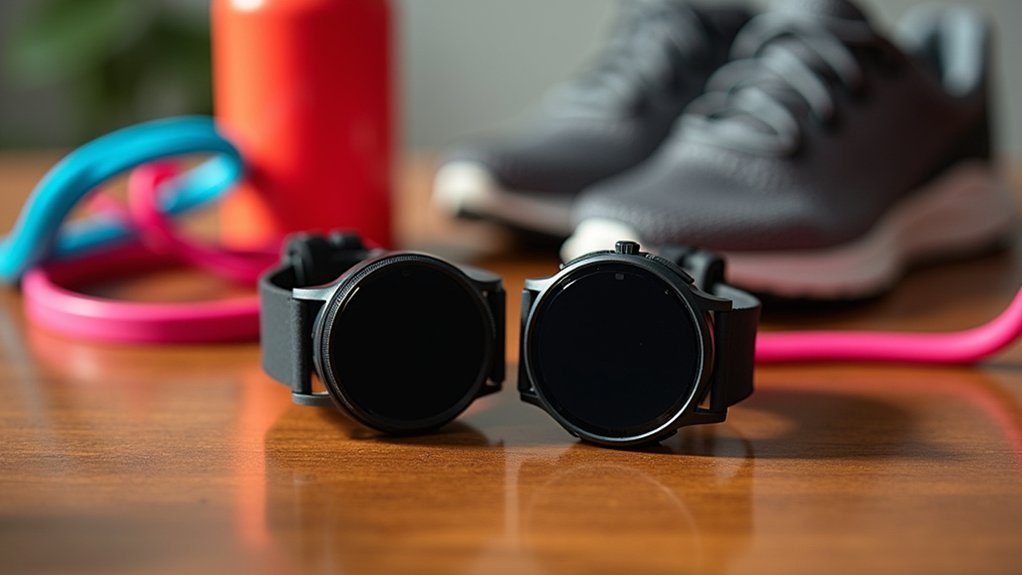
While Samsung dominates the smartwatch market, Garmin’s Venu and Vivoactive series excel where fitness-focused users need them most: robust offline music capabilities combined with serious athletic tracking.
You’ll get up to 500 songs stored locally on your watch, perfect for long runs or gym sessions without your phone. The Spotify integration requires Premium but delivers seamless playlist syncing through Garmin’s Connect IQ app.
Both series offer exceptional GPS accuracy, heart rate monitoring, and battery life that won’t quit mid-workout.
You can control playback directly from your wrist while accessing advanced features like stress tracking and sleep analysis.
The setup’s straightforward: pair with Garmin Connect, install the Spotify app, and sync your playlists while charging. To maintain access to your music, you’ll need to sync every 15 days to prevent your downloaded content from expiring.
Fitbit Sense and Versa: Cross-Platform Compatibility With Extended Battery Life
If you’re seeking a Spotify-compatible wearable that works seamlessly across Android and iOS devices, Fitbit’s Sense and Versa series offer compelling cross-platform functionality with impressive multi-day battery life.
You’ll find varying levels of Spotify integration depending on which generation you choose, from full offline app support on older models to music controls on newer versions. The Fitbit Ionic also provides Spotify compatibility alongside the Versa lineup for users seeking additional options.
These fitness-focused smartwatches deliver up to six days of battery performance, ensuring your music controls and health tracking won’t leave you tethered to a charger.
Spotify Integration Features
Although newer Fitbit models have discontinued Spotify support, the Fitbit Sense and Versa 3 still offer robust music integration that transforms how you control your Premium account across multiple devices.
You’ll enjoy seamless cross-platform compatibility through Spotify Connect, allowing you to manage playback across up to eight connected devices from your wrist. The integration uses Bluetooth connectivity to control music on your phone while providing essential features like playlist navigation and track liking. A Spotify Premium account is required to access these advanced control features and ensure full functionality across all connected devices.
Key Spotify integration features include:
- Playback Management – Control play, pause, skip, and volume directly from your watch
- Playlist Navigation – Browse and select from your Spotify playlists without touching your phone
- Track Interaction – Like songs using the heart icon and enable shuffle mode
- Multi-Device Control – Switch between different Spotify Connect devices seamlessly
Multi-Day Battery Performance
When you’re choosing between the Fitbit Sense 2 and Versa 4 for your Spotify Premium experience, battery longevity becomes essential since you’ll want uninterrupted music control throughout your day.
Both models deliver impressive multi-day performance, lasting up to 6 days depending on your usage patterns. This represents a significant improvement over the original Sense, which only lasted 1-2 days for many users.
Your actual battery life will vary based on features you enable and environmental conditions. Frequent GPS usage, heart rate monitoring, and constant notifications can reduce performance.
You can extend battery life by adjusting screen brightness and disabling unnecessary features. However, be aware that recent software updates have caused battery life reductions for some users, though Google has offered compensation for affected customers.
The Community Forums provide valuable insights from real users sharing their experiences with battery performance and troubleshooting tips for both devices.
Android Ios Support
Both Fitbit Sense 2 and Versa 4 deliver seamless cross-platform compatibility, working effortlessly with Android and iOS devices through the widely available Fitbit app.
You’ll find the same core functionality regardless of whether you’re using Google Play Store or Apple App Store versions.
However, you should know these devices don’t support the dedicated Spotify app that was available on earlier Versa models. Instead, you’ll control your Spotify Premium playback through music controls on your wearable while your phone handles the actual streaming. For users seeking full Spotify and fitness app compatibility, the Google Pixel Watch line offers dedicated support for both Spotify and running applications like C25K.
Key considerations for cross-platform integration:
- WiFi Connection: Both devices must connect to the same network
- Premium Account: Spotify Premium subscription required for full functionality
- Platform Features: Some capabilities vary between Android and iOS
- Syncing Requirements: Proper device syncing guarantees peak performance
WearOS Alternatives: TicWatch and Fossil Gen 6 for Budget-Conscious Users
If you’re seeking budget-friendly Wear OS options that don’t compromise on Spotify functionality, TicWatch and Fossil Gen 6 watches offer compelling alternatives to premium smartwatches.
You’ll get full Spotify app features including offline downloads, playlist management, and seamless music control directly from your wrist. These devices require Wear OS 2.2 or higher to ensure proper Spotify compatibility and optimal app performance.
While these affordable options deliver solid performance, you’ll want to evaluate how their battery life compares to guarantee uninterrupted music streaming during your daily activities.
Full Spotify App Features
While Apple Watch users face limitations with Spotify’s basic remote control app, WearOS smartwatches like TicWatch and Fossil Gen 6 models offer the full Spotify experience directly from your wrist.
You’ll get extensive playback controls including play, pause, skip, shuffle, and repeat functions. Your entire personal library, playlists, and liked songs are accessible without your phone.
Most importantly, you can download content for offline listening with your Premium subscription. However, users should be aware that limited storage on WearOS devices requires monitoring space usage when downloading playlists and albums.
Here’s what sets these budget-friendly WearOS devices apart:
- Direct streaming – Play music, podcasts, and audiobooks independently from your watch
- Offline downloads – Sync playlists and albums over Wi-Fi for phone-free listening
- Spotify Connect integration – Control playback on other devices remotely
- Premium audio quality – Access high-quality streaming and download settings
Affordable WearOS Options
Budget-conscious users don’t need to spend Apple Watch money to enjoy premium Spotify features on their wrist. The TicWatch E3 and TicWatch Pro 3 offer excellent value, with the Pro 3’s dual-layer display providing superior battery efficiency and sunlight visibility.
Fossil’s Gen 6 combines modern aesthetics with frequent promotional pricing, making it another compelling option.
All these watches run standard WearOS 2.0+, ensuring full Spotify app compatibility. You’ll get complete music controls, playlist management, and offline downloads for Premium subscribers. Users can also access Heavy Rotation tiles for quick media controls and convenient music management. Prices typically range from $150-$350, often dropping below $250 during sales.
Look for Snapdragon Wear 4100+ processors for smooth performance and Bluetooth headphone support for wireless listening. Refurbished options provide additional savings while maintaining reliable functionality.
Battery Life Comparison
When choosing between TicWatch and Fossil Gen 6 smartwatches for Spotify streaming, battery performance becomes the deciding factor for many users.
TicWatch models clearly outperform Fossil’s offering, especially for music enthusiasts who need extended playback time.
Here’s how these watches compare for Spotify users:
- TicWatch Pro 5 Enduro – Over 90 hours smart mode, up to 3 days with light Spotify usage
- TicWatch Pro 3 Ultra GPS – Up to 72 hours smart mode, dual-display technology saves power
- Fossil Gen 6 – Only 24-36 hours typically, drops under one day with regular streaming
- Essential Mode Advantage – TicWatch’s 45-day standby extends battery when you’re not streaming
The TicWatch Pro 3 Ultra GPS features over 100 professional workout modes alongside its impressive battery performance.
You’ll get considerably longer battery life with TicWatch models, making them ideal for heavy Spotify users.
Offline Music Storage: Maximizing Spotify Downloads on Limited Watch Memory
Since smartwatches typically offer limited storage space compared to smartphones or tablets, you’ll need to strategically manage your Spotify downloads to make the most of your device’s memory constraints.
Spotify Premium allows up to 10,000 songs per device, but your watch’s actual capacity will likely be much lower. Remember that downloads are limited to 5 different devices maximum, so your smartwatch will count as one of these allocated slots.
Prioritize your most frequently played playlists for offline storage. Remove unused tracks regularly to free up space for new downloads. You can easily manage this through the Spotify app by toggling downloads on and off for specific playlists.
Consider rotating your music selection based on your listening patterns. Download workout playlists during gym seasons, then switch to travel playlists when needed. This smart downloading approach guarantees you’re maximizing your limited watch storage while keeping your favorite music accessible offline.
Battery Performance: How Music Streaming Affects Smartwatch Longevity
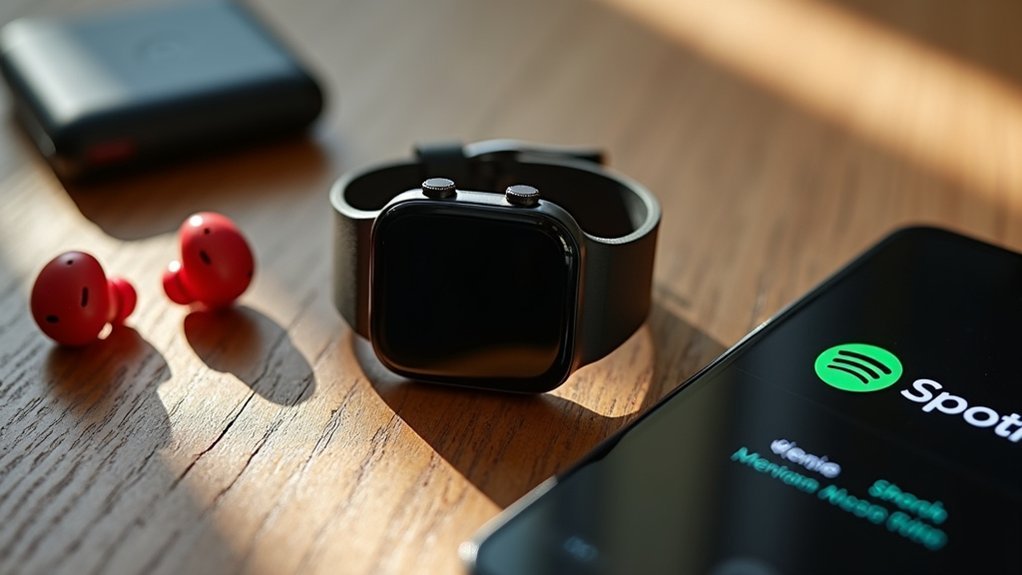
Your smartwatch’s battery life takes a significant hit when you’re streaming Spotify versus playing downloaded tracks, since streaming requires continuous Bluetooth connectivity and data transmission.
You’ll notice models like the OnePlus Watch 2 and Galaxy Watch Ultra offer the best balance for music lovers, delivering three to four days of use even with active streaming.
If you prioritize marathon listening sessions, consider the Garmin Enduro 3’s month-long battery life or solar-powered options that virtually eliminate charging concerns. The VOOC charging technology in the OnePlus Watch 2 can fully charge its 500mAh battery in an hour or less, making it convenient for users who stream music frequently.
Streaming Vs Offline Impact
The way you listen to music on your smartwatch dramatically affects how long your battery lasts throughout the day. Streaming music through Spotify creates significant battery drain compared to offline playback, with some users experiencing 90% battery loss in just 20 minutes on devices like the Apple Watch SE.
Here’s how streaming impacts your battery differently than offline playback:
- Network Activity – Streaming requires constant wireless radio use for data transfer, while offline uses stored files.
- Processing Power – Your watch works harder decoding streamed audio and managing network connections versus accessing local files.
- Signal Strength – Poor connectivity forces your watch to boost antenna output, increasing power consumption dramatically. Devices with dual-frequency GPS like the Apple Watch Ultra provide more precise location tracking but can further impact battery performance during streaming activities.
- Background Operations – Streaming apps keep more processes running, adding incremental battery load throughout your listening session.
Extended Battery Life Models
Five smartwatches stand out when you’re prioritizing battery longevity while maintaining Spotify compatibility.
The Garmin Enduro 3 delivers unprecedented 36-day battery life, extending to 90 days with solar charging and conservative use. However, it lacks live Spotify streaming support, limiting you to basic smartwatch features.
The Garmin Fenix 7 Solar offers 22 days with solar charging and up to 173 days in battery saver mode, providing excellent music storage capabilities.
The Forerunner 165 Music balances performance with 11 days of battery life and dedicated offline Spotify support.
For Android users, the Galaxy Watch Ultra provides 3-4 days with seamless Spotify integration. Many popular models require daily charging, leading to frequent interruptions in your music streaming experience.
The TicWatch 5 Pro extends to 45 days in low-power mode but drops considerably during active streaming.
Fitness Integration: Syncing Spotify Playlists With Workout Routines
Most fitness enthusiasts discover that syncing Spotify playlists with their workout routines transforms their exercise experience from mundane to motivating.
You’ll enjoy seamless music control directly from your wrist, eliminating the need to fumble with your phone mid-workout.
The integration offers powerful benefits that enhance your fitness journey:
- Control playback – Play, pause, skip tracks, and browse favorites without switching apps
- Download playlists – Access your music offline during workouts without internet connectivity
- Create motivational content – Customize playlists based on specific workout types and intensities
- Stream diverse content – Access music, podcasts, and audiobooks to keep workouts engaging
With Strava integration, you won’t need to switch between apps, making your workout sessions more focused and productive. Popular artists like Drake and Rihanna frequently dominate workout playlists, helping users maintain high energy levels throughout their fitness routines.
Platform Limitations: Android Vs Ios Compatibility Across Watch Brands
However, choosing the right wearable for your Spotify experience isn’t just about features—it’s about ensuring compatibility between your smartphone’s operating system and your preferred watch brand.
Android users enjoy broader options, with Samsung Galaxy Watch, Google Pixel Watch, and TicWatch models offering offline downloads and standalone playback. You’ll find easier app installation through Google Play Store across multiple brands.
iOS users face more restrictions. While Apple Watch provides excellent Spotify integration, you’re limited to fewer third-party options like select Fitbit and Garmin models. Before investing in any wearable, check with device manufacturers for support since compatibility varies significantly across different watch models and brands.
| Platform | Compatible Brands | Offline Support | Standalone Playbook |
|---|---|---|---|
| Android | Samsung, Google, Fitbit, TicWatch | Premium models only | Select models |
| iOS | Apple, select Fitbit/Garmin | Apple Watch + limited others | Mostly requires iPhone |
| Both | Garmin, some Fitbit | Model-dependent | Feature variance |
| Neither | Budget/older watches | Remote control only | Phone required |
Price-to-Feature Analysis: Choosing the Best Value Spotify-Compatible Wearable
When you’re evaluating Spotify-compatible wearables, the price-to-feature ratio varies dramatically across different device categories.
Here’s how each option stacks up for value-conscious buyers:
Smart shoppers need to weigh storage capacity, battery life, and specialized features against upfront costs when choosing their ideal Spotify wearable.
- Budget Champion: PECSU P5S MP3 player offers the most affordable entry point with custom streaming app support and decent battery life for basic offline Spotify needs.
- Mid-Range Sweet Spot: Samsung Galaxy Watch 7 ($259 Bluetooth) delivers 32GB storage, standalone playback, and full smartwatch functionality at a competitive price.
- Specialized Value: Mighty Vibe focuses exclusively on music playback with extended battery life, perfect if you don’t need smartwatch features.
- Premium Investment: Google Pixel Watch 3 and high-end Garmin models ($300+) justify their cost with advanced features but offer diminishing returns for music-only users. The Garmin Venu 3 stands out with its exceptional 14-day battery life that significantly reduces charging frequency compared to daily-charging alternatives.
Frequently Asked Questions
Can I Use Spotify on My Smartwatch Without a Premium Subscription?
You can use Spotify on your smartwatch without Premium for basic controls like play, pause, and skip while streaming online. However, you can’t download music for offline playback without a Premium subscription.
Do I Need My Phone Nearby to Stream Spotify on My Watch?
You don’t need your phone nearby for most Wear OS watches and Apple Watches with Premium subscriptions. They’ll stream independently using their own internet connection or offline downloads.
Which Smartwatches Support Spotify Podcasts and Audiobooks, Not Just Music?
You’ll find podcast and audiobook support on Wear OS devices, Samsung Galaxy Watch, and Fossil Gen 6. These smartwatches let you download and stream Spotify’s full content library beyond just music tracks.
How Much Cellular Data Does Streaming Spotify Directly From My Watch Use?
Streaming Spotify directly from your watch uses 25-150 MB per hour depending on audio quality settings. You’ll consume less data with low quality at 25 MB hourly versus very high quality at 150 MB.
Can I Control Spotify on Other Devices Through My Smartwatch App?
Yes, you can control Spotify on other devices through your smartwatch using Spotify Connect. You’ll select playback devices like phones or speakers, adjust volume, and manage playback when they’re on the same network.
In Summary
You’ll find the perfect Spotify-compatible wearable by considering your priorities: Android users can’t go wrong with the Pixel Watch 3’s seamless integration, while fitness enthusiasts should lean toward Garmin’s offline capabilities. Don’t overlook battery life when streaming music regularly, and remember that iOS compatibility varies greatly across brands. Whether you’re budget-conscious or seeking premium features, matching your platform, lifestyle, and musical habits guarantees you’ll make the smartest purchase decision.

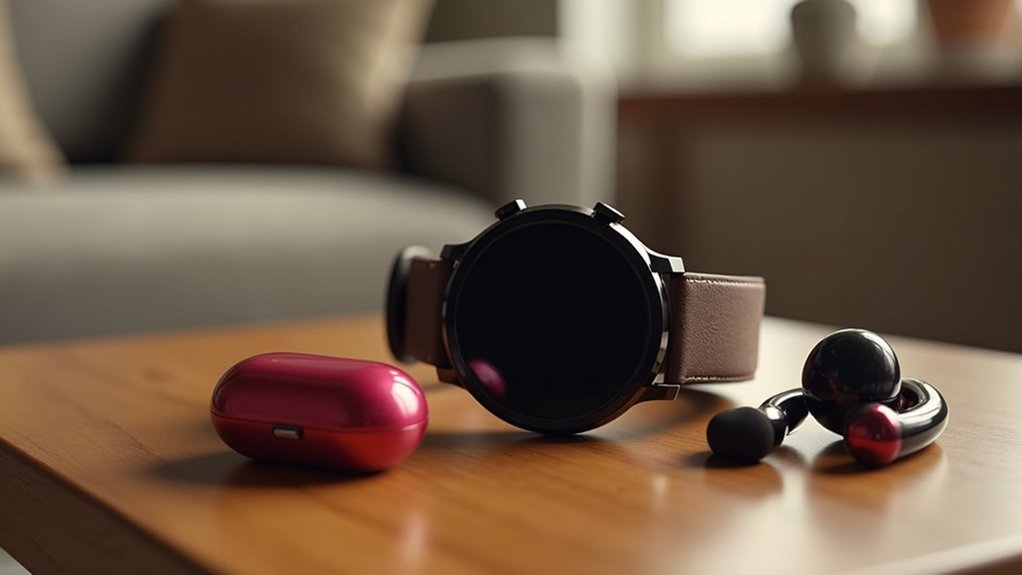


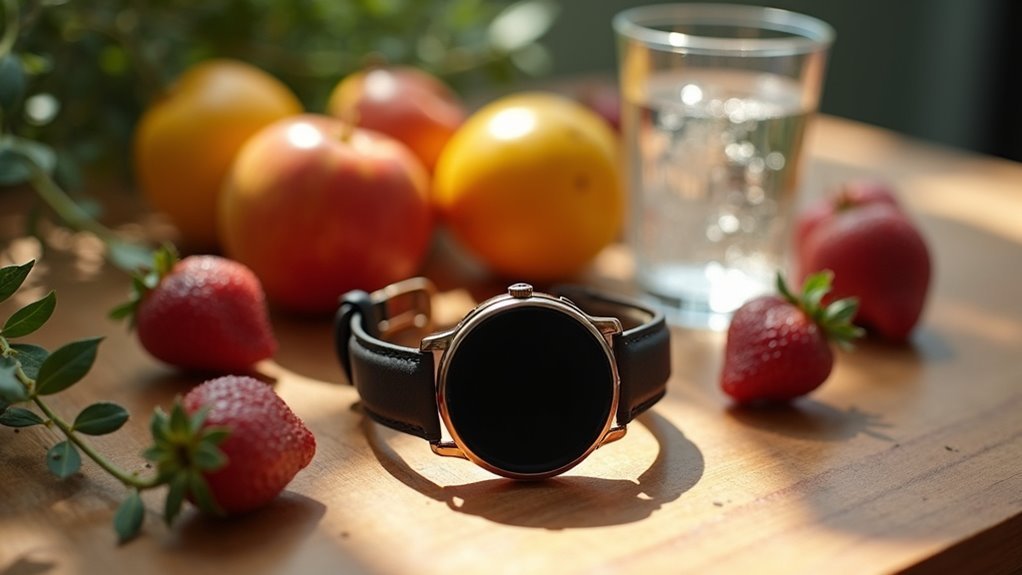
Leave a Reply